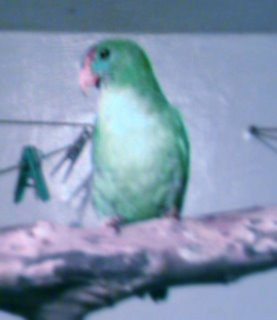Philippine Hanging Parrot
This is certainly not a beginner’s parrot. Generally shy, hard to tame and with pretty significant special requirements, think twice before getting (or, as in my case, adopting one). Having said that, they are lovely little animals and their quirky habit of hanging upside down when they sleep (sorry… no photo) and their constant antics will entertain you for hours.
Feeding: Philippine hanging parrots feed primarily on fruit. I feed mine pawpaw (papaya) as a staple and occasionally give it a piece of mango or a banana. With both pawpaw and banana they make an unholy mess – mashing the pulp in their curiously designed beak to remove all the juices before flinging their heads to get rid of it, chucking it in all directions. Its previous owners couldn’t handle this. I occasionally also hang a piece of spray millet in its cage, which it enjoys playing with and I think eats a bit of as well. As I keep a Java Rice Finch with it I always have seeds in the cage as well. These are not necessary, but I often see it investigating them (I don’t know if it actually eats any – other observations would be welcomed). With bananas it doesn’t make as much of a mess, but I don’t think it likes them much.
Water is important, especially as hanging parrots love to take baths on hot days. Otherwise I think it gets much of its fluids from the fruit it eats.
Housing: A regular bird cage will do. Anything you would keep a cockatiel in, but ideally with a flat roof so that the parrot can sleep hanging from it. Mine loves to display on a long, horizontal perch – running along it while uttering high-pitched chirps. Try to simulate the forest canopy, without completely removing flying space. These birds are made for running along branches and climbing through foliage so I keep several perches (mostly horizontal but with one at an angle) of different diameters positioned so that he can jump form one to the next. Adding a palm frond every week or so (you’ll need to change it) will provide it with hours of fun.
Taming: I’ve tamed several small parrots before, namely two lovebirds and two budgies. However, I found this little parrot immensely hard to tame – in fact I’ve failed. If you want a bird that will sit on your shoulder either A) get a captive bred one or B) get a budgie. In any case, if you intend to try I suggest you go with the perch method. They aren’t the smartest parrots, so the perch method (getting it used to stepping onto a perch you’re holding then making the perch progressively shorter) is the most likely to give results. As you can hopefully see in the rather poor quality photo, mine is tame to the point that I can take it out one a week or so to give it some exercise in my ‘bird run.’ Getting him back into the cage is usually far harder than getting him out – he’s far more agile than more conventional pet birds. A lesson I very nearly learnt the hard way - - never let your hanger out of its cage with lovebirds around. Lovebirds are the pit-bulls of the parrot world. Actually, never let any bird out while your lovebirds are out of their cage. Mine would even gang up on 1month old ducklings (considerably bigger than them)!
Final note: When I got mine I decided he desperately needed to have his nails clipped, so I did. However, it seems that this species naturally has very long nails which it uses to grip branches and foliage when hanging upside-down. Therefore, if your bird’s nails are so long that it is getting stuck on the cage bars, have them clipped (only clip them yourself if you know how and have something to stop any bleeding – flour never works for me). Otherwise give it perches or different diameters and textures and it should wear them down to an appropriate size. Mine has black nails, so it is really hard to see the veins. Never let these birds out in a room that has insect screening. There is nothing worse than trying to free a small, frightened bird that has it’s nails stuck in an insect screen – I know. If you have an accident provide it with a perch right under its belly and with a long, thin stick try to carefully jiggle each nail out of the screen. Do not grad your bird and pull! Even if you manage not to harm it, it would probably never forgive you.



2 Comments:
Hi.The diet sounds very inflexible.They eat lots vegetables too.They are definitely not for beginners but when you say that you feed them only three kinds of fruit:bananas,papayas and mangos.It sounds much easier than it really is.They also need to be happy or else there is no point in owning a Philippine Hanging Parrot.
They need plenty branches to exercise and keep themselves entertained and not bored because these are very acrobatic birds.
Thanks for the advice! This blog is entirely first hand experiance and I can only say what I find works for me... these suggestions are always welcome! What kinds of vegetables?
I completely agree on the need for branches! Do not obstruct all the flying space, but this species is very active and loves to run along branches. As I said in the blog, try to simulate a canopy.
Thanks for the advice!
Post a Comment
<< Home